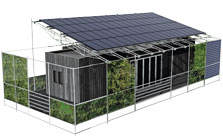

The Cornell house is designed to be highly efficient and easy to maintain and upgrade.
Download Construction Drawings
(Zip 24 MB)
Neither the United States, nor the Department of Energy, nor the Alliance for Sustainable Energy LLC, nor any of their contractors, subcontractors, or their employees make any warranty, express or implied, or assume any legal liability or responsibility for the accuracy, completeness, or usefulness for any purpose of any technical resources or data attached or otherwise presented here as reference material.
Solar Decathlon 2007
Cornell University
Raising the Bar on Sustainability
How do you keep more than 100 students from architecture, engineering, and business disciplines focused on building a futuristic solar house? "Streamlined teams, flexibility, continuous meetings, and consensus building," says Andrew Chessen, who leads the business team.
Cornell's organizational strategy is reflected in the unique construction of a "Light Canopy," which is adapted to their solar house. The Light Canopy's streamlined framework of steel trusses serves as a support for PV, evacuated tubes for solar water heating, and a series of vegetated screens that provide shade in the summer.
This framework allows homeowners a great deal of flexibility in how they integrate renewable energy systems because it can be set up independently of an existing structure. For example, they can add, remove, and rearrange components without having to modify the house. Raised flooring allows ductwork and wiring to be easily upgraded.
Cornell has a reputation for being particular—the team performed strongly in the 2005 Solar Decathlon and brought home second-place honors. "Cornell didn't need to build another house," says David Bosworth, who leads the architecture and construction team. "But we do need to raise public awareness and encourage residential solar energy."
Honoring this commitment to educate their peers and the public, the team initiated educational activities in their community: introducing students in city schools to solar energy and energy efficiency; collaborating with Cornell's Ecology House on an Earth Day event; and setting up demonstrations at the local Farmers Market.
"This hands-on experience has shaped career directions of many of our students and changed the way they view the environment," says Faculty Advisor Matthew Ulinski.
Bernardo Menezes, engineering team lead, agrees. "The independent nature of the team is what made this experience so valuable. The students decided the direction of the project and this gave us a sense of ownership." Controlling their destiny and their desire to raise public awareness on sustainable living is fundamental to the team's creativity.
Team Contact
Matthew Ulinski
mu25@cornell.edu
